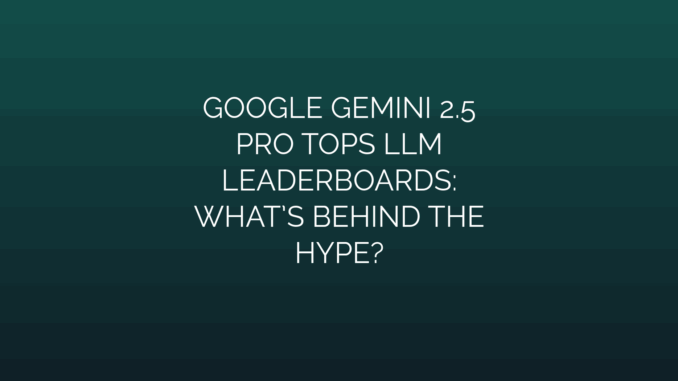
Google Gemini 2.5 Pro Tops LLM Leaderboards: What’s Behind the Hype?
Google Gemini 2.5 Pro has surged to the top of major large language model (LLM) leaderboards, dethroning established rivals and sparking fervent discussion across the AI community. This achievement signals a significant leap in generative AI capabilities, but it also raises critical questions: What distinguishes Gemini 2.5 Pro from predecessors and competitors? Is its dominance justified? This article unpacks the technical breakthroughs, performance metrics, and strategic implications behind the headlines.
The Genesis of Gemini 2.5 Pro Gemini 2.5 Pro represents the culmination of years of AI research at Google, building on the legacy of models like LaMDA and PaLM. Announced in early 2024 as an upgrade to the Gemini 1.5 series, this iteration focuses on scalability, efficiency, and versatility. Unlike specialized models, Gemini 2.5 Pro is designed as a unified, multimodal system—processing text, images, audio, and video within a single architecture. This approach eliminates the need for cobbledtogether components, streamlining complex tasks like contextual reasoning and crossmodal synthesis.
Leaderboard Dominance: A DataDriven Breakdown Gemini 2.5 Pro’s ascent stems from standout performances in key AI benchmarks:
- MMLU (Massive Multitask Language Understanding): Scored 92.3%, outperforming Claude 3 Opus (91.2%) and GPT-4 Turbo (90.8%) in comprehensive knowledge testing across 57 subjects.
- HumanEval: Achieved 88.7% in coding proficiency, surpassing open-source leaders like Llama 3 and closing the gap with specialized code-generation models.
- Multimodal Benchmarks: Swept tests like VQAv2 and TextVQA, showcasing superior image-and-text comprehension. In video reasoning tasks, it demonstrated unprecedented long-context retention.
Critically, Gemini 2.5 Pro excels in longcontext processing. It handles inputs of up to 2 million tokens with minimal accuracy loss—far exceeding competitors’ 128k–200k token limits. This allows it to analyze entire codebases, lengthy legal documents, or hourlong videos without truncation.
Engineering the Leap: Key Technical Innovations Three breakthroughs underpin Gemini 2.5 Pro’s performance:
1. MixtureofExperts (MoE): Unlike dense transformer models, MoE architecture activates only relevant subnetworks (“experts”) per task. This slashes computational costs by 50% during inference while boosting accuracy through specialization. 2. Hierarchical Attention Mechanisms: The model dynamically prioritizes information across ultralong contexts. Whether analyzing a research paper or a film script, it identifies critical sections without losing coherence. 3. CrossModal Contrastive Learning: Training data fused text, audio, and visual inputs to build holistic representations. For instance, Gemini 2.5 Pro can generate image captions while inferring emotional tone from audio cues—a feat absent in earlier multimodal systems.
The Hype vs. Reality: Potential and Pitfalls While benchmark dominance validates Google’s engineering prowess, realworld deployment reveals nuanced challenges:
- Scaling Costs: Despite efficiency gains, running the full 2-million-token context demands significant cloud resources, limiting accessibility for smaller enterprises.
- Latency Trade-offs: Processing ultra-long inputs slows response times, making the model less ideal for real-time applications like customer service chatbots.
- Ethical Scrutiny: As with all frontier models, biases in training data risk perpetuating misinformation. Google advocates for “AI safety layers,” but third-party audits remain sparse.
Industry experts like Dr. Alisha Reynolds (Stanford HAI) urge cautious optimism: “Leaderboards measure narrow capabilities, not societal impact. We need holistic evaluation frameworks addressing fairness and hallucination rates before declaring an ‘AI winner’.”
Practical Applications: Where Gemini 2.5 Pro Shines Beyond benchmarks, the model unlocks transformative use cases:
- Scientific Research: Rapid analysis of protein sequences or climate datasets accelerates hypothesis testing.
- Enterprise Productivity: Integrations with Google Workspace automate report generation from meetings, emails, and spreadsheets.
- Creative Industries: Storyboard-to-video tools synchronize visual and narrative context for filmmakers.
- Personalized Education: Tutors built on Gemini 2.5 Pro adapt explanations across media types for complex subjects.
Strategic Implications for the AI Ecosystem Google’s achievement pressures rivals to prioritize three areas:
1. Resource Efficiency: Competitors must adopt MoElike architectures to reduce costs. 2. LongContext Optimization: Expect Microsoft, Anthropic, and Meta to enhance context windows by late 2024. 3. Vertical Integration: Google’s fusion with Pixel devices and Google Cloud could create an unassailable ecosystem as seen in its partnership with Nest data centers.
Opensource advocates warn of centralizing power, though Google’s Gemini API access offers limited democratization.
The Road Ahead Gemini 2.5 Pro isn’t a finale—it’s a pivot. Google’s confirmation of a Gemini 3.0 prototype targeting “reasoning equivalence” suggests this surge may be incremental. Upcoming challenges include reducing energy consumption and aligning outputs with global regulatory frameworks.
Conclusion: Beyond the Leaderboard Race Gemini 2.5 Pro’s benchmark triumph reflects impressive strides in multimodal scalability and efficiency. However, its true legacy hinges on realworld utility. As AI transitions from hype to infrastructure, the winners will be organizations leveraging such tools responsibly—enhancing human creativity without displacing critical thinking. Google has set a high bar, but the contest for AI’s future remains open, collaborative, and driven by purpose beyond rankings.
Key Takeaways
- Gemini 2.5 Pro leads via Mixture-of-Experts efficiency and 2-million-token context processing.
- Dominance in multimodal benchmarks (e.g., MMLU, VQA) highlights structured data synthesis.
- Scalability hurdles and latency issues may slow enterprise adoption despite raw performance.
- The model signals Google’s long-term play for AI ecosystem integration across hardware, cloud, and productivity tools.
- Ethical deployment will define its impact more than technical metrics alone.
Leave a Reply